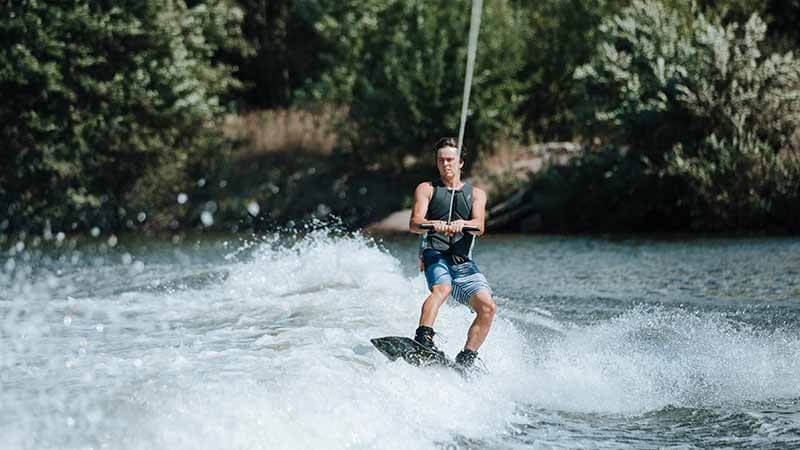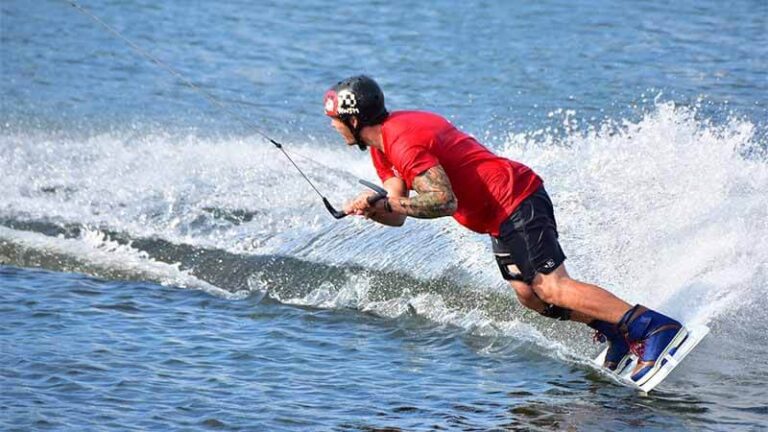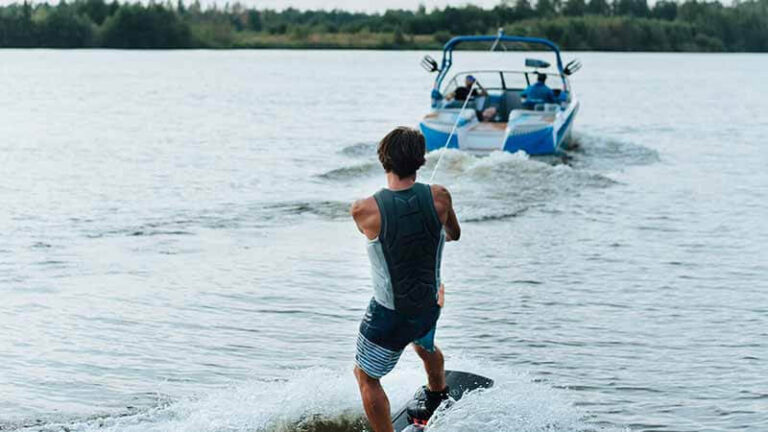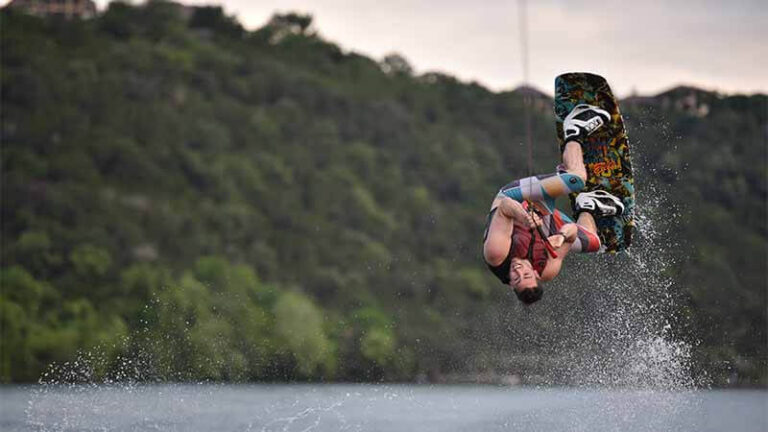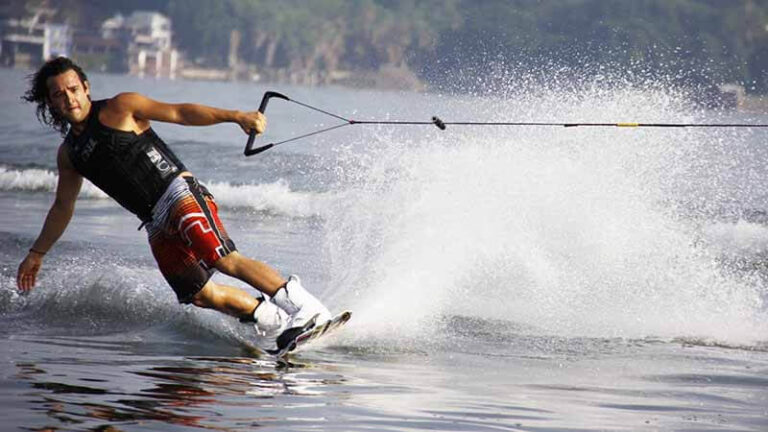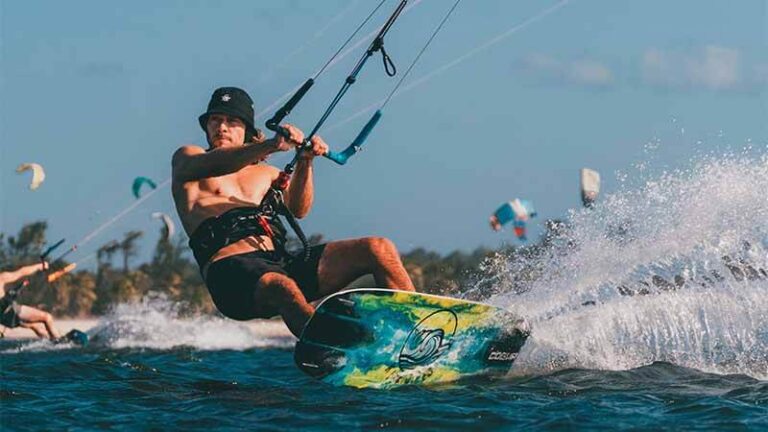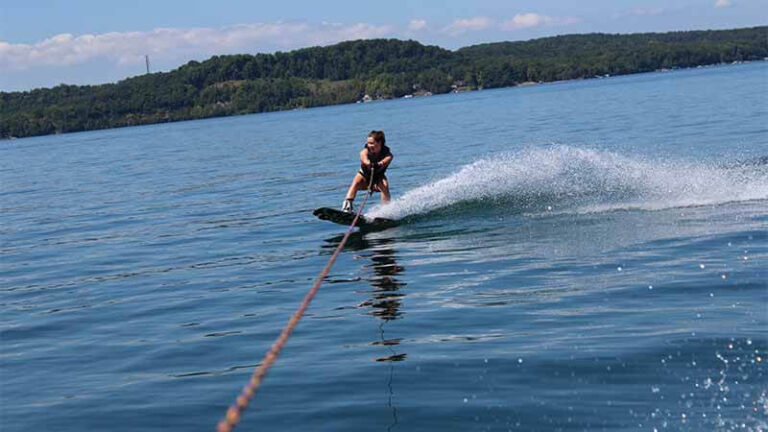Different Types of Wakeboard Ropes and Their Benefits
Wakeboarding is an exciting water activity that has grown in popularity in recent years. It entails riding a wakeboard, which looks like a hybrid between a snowboard and a water ski, across the water while being towed by a boat.
The rider stands sideways on the wakeboard and carves across the water’s surface, completing numerous tricks and maneuvers while hanging onto a rope-attached handle. This thrilling pastime draws individuals of all ages and ability levels, from beginners looking for a pleasant way to spend time on the water to seasoned professionals pushing the sport’s boundaries with astounding acrobatics.
Wakeboarding’s allure stems from its perfect combination of adrenaline-pumping activity and a peaceful connection with the water. Riders can enjoy the thrill of grabbing air off the wake of the boat and performing flips, spins, and grabs while gliding across the water’s surface.
As wakeboarding continues to captivate water enthusiasts worldwide, it is critical for players to ensure they have the proper equipment, with the wakeboard rope being a critical component.
Importance of choosing the right wakeboard rope
The wakeboard rope is an often neglected yet essential component of wakeboarding equipment. It connects the rider to the boat by delivering power from the boat’s engine to the wakeboarder. The perfect wakeboard rope may make or break a rider’s performance, safety, and overall experience on the water.
The length and thickness of a wakeboard rope are important factors to consider when purchasing one. The distance between the rider and the boat is determined by the length of the rope, which influences the size and shape of the wake that the rider can use to do stunts.
Longer ropes for greater wakes may be preferred by experienced riders, enabling bigger air and more sophisticated maneuvers. Shorter ropes, on the other hand, are ideal for beginners or people who prefer a smoother, less violent ride.
The thickness of the rope is also important because it determines its strength and durability. Thicker ropes are more durable and can handle the tension and stress of fast wakeboarding, guaranteeing a strong connection between the rider and the boat. A somewhat thinner rope may be more forgiving and comfortable to hold for novices or leisure riders.
The main goal of this blog article is to delve into the world of wakeboard ropes and investigate the numerous types available on the market. We’ll look at three varieties of wakeboard ropes: Spectra, Polyethylene, and Hybrid. Each model has distinct traits and perks that appeal to various rider preferences and ability levels.
First, we’ll look at Spectra wakeboard ropes. These ropes are noted for having a low stretch and providing consistent performance and response. They are also light and floatable, making them easy to handle and keep on the water’s surface. Furthermore, Spectra ropes have remarkable durability and abrasion resistance, ensuring a longer lifespan even with regular use.
Second, we’ll go over Polyethylene wakeboard ropes. These ropes find a good combination of flexibility and responsiveness, making them ideal for riders looking for a dependable and cost-effective solution. Polyethylene ropes are popular among casual wakeboarders who want a trustworthy rope without breaking the bank because of its high strength and longevity.
Finally, we will look into hybrid wakeboard ropes, which blend materials to provide customizable qualities and improved performance. These ropes are adaptable to many riding styles and ability levels due to their versatility. Hybrid ropes are created to meet specific needs by combining the benefits of several materials into a single rope to improve the wakeboarding experience.
Understanding Wakeboard Ropes
Characteristics of wakeboard ropes
Wakeboard ropes are specially constructed ropes that are used to attach the rider to the boat when wakeboarding. Because of their special properties that cater to the specific demands of the activity, these ropes differ greatly from normal ropes.
The strength of wakeboard ropes is one of their most essential properties. Wakeboard ropes are made of materials that can endure high-tension forces as well as the stresses that come with intense riding and trick execution.
Another important aspect is the rope handle’s grip. Wakeboard ropes often have pleasant, grippy handles composed of rubber or foam. The grip is essential since riders must hold on tightly when performing acrobatics and move behind the boat. A solid grip keeps the handle from slipping out of the rider’s hands, making wakeboarding safer and more pleasurable.
Furthermore, wakeboard ropes include a floatable segment of the line. This floating segment is typically composed of foam or buoyant materials and aids in keeping the rope on the water’s surface, making it easier for the rider to retrieve after a fall. A floating rope is very useful for beginners who may struggle to handle the rope while learning how to wakeboard.
Relevance of rope length and thickness for different riding styles and skill levels
Wakeboard rope length and thickness are critical in adapting the ride to the rider’s style and ability level. The distance between the rider and the boat is determined by rope length, which influences the size and shape of the wake produced by the boat. Longer ropes result in more extended lines, which result in greater wakes.
This is beneficial for advanced riders who require a larger wake to do higher leaps and more complex stunts. Shorter ropes, on the other hand, are ideal for beginners or people who prefer a smoother, less aggressive ride with fewer wakes.
The thickness of the rope also has an impact on the wakeboarding experience. Thicker ropes are more durable and stronger, able to handle the forces applied during high-speed riding and violent feats. They provide a secure connection between the rider and the boat, making them popular among skilled wakeboarders. Thicker ropes are also less likely to tangle, which adds to their use.
Thinner ropes, on the other hand, provide more flexibility and elasticity, which might be advantageous for riders looking for a more forgiving and comfortable ride. A thinner rope’s stretch absorbs shocks and decreases the impact on the rider’s arms and upper body during jumps and landings. This is especially beneficial for novice cyclists or those who prefer a more calm and less intense ride.
Significance of stretch and flexibility in wakeboard ropes
Wakeboard rope stretch and flexibility are important aspects to consider when selecting the proper rope for a specific riding style and ability level. Stretch is the ability of a rope to extend under tension, and it has both advantages and problems.
Stretching can be advantageous because it works as a shock absorber, minimizing strain on the rider’s arms and shoulders during take-offs and landings. This reduces jarring impacts and allows for more fluid transitions between maneuvers. It also offers a more forgiving environment for beginners who are still honing their skills.
Too much stretch, on the other hand, can be damaging to performance, especially for skilled riders who require an accurate and quick response from the rope. Excessive stretch can cause a delayed reaction, impairing the rider’s control and trick timing.
Wakeboard ropes with low flexibility, on the other hand, are frequently favored by experienced riders who demand consistent performance and quick reactivity. These ropes enable precise maneuvering and are great for performing complex acrobatics requiring split-second timing.
The stretch of wakeboard ropes is closely connected to their flexibility. Flexible ropes improve overall mobility and handling by allowing riders to easily change the rope to their desired position during twists and feats. A flexible rope can substantially enhance wakeboarding fun for riders looking for a more dynamic and nimble experience.
Spectra Wakeboard Ropes
Because of its remarkable performance properties, Spectra ropes are a favorite choice among wakeboarders. Spectra is a synthetic fiber with a high strength constructed of ultra-high molecular weight polyethylene (UHMWPE). This material is well-known for its high tensile strength, which is several times that of steel on a weight-for-weight basis.
As a result, Spectra ropes can withstand high amounts of tension and stress while maintaining structural integrity. The usage of UHMWPE also contributes to the weightlessness of the rope, making it easier to handle and maneuver during wakeboarding sessions.
To increase the strength and durability of Spectra ropes, they are braided with several strands. The braiding method distributes the load uniformly over the rope, lowering the danger of weak spots or places of failure. This method of construction also contributes to the rope’s suppleness, allowing riders to make quick changes and perform precise movements on the water.
Advantages of Spectra ropes for wakeboarding
Minimal stretch for consistent performance and responsiveness
One of the most important benefits of Spectra ropes is their low stretch. Unlike standard wakeboard ropes consisting of materials such as nylon, Spectra ropes elongate relatively little under tension. This feature correlates to the wakeboarder having immediate reactivity and accurate control.
Riders can feel the boat’s movements and make real-time modifications to improve their performance and trick execution. The reduced stretch also improves the overall consistency of the rope, allowing riders to maintain a predictable and steady pull, which is especially critical for advanced maneuvers.
Lightweight and floatable properties for ease of use and safety
Spectra ropes are lightweight, making them not only easy to handle but also reducing pressure on the rider’s arms and upper body during long rides. The rope’s lightweight allows for increased agility and fluidity on the water, allowing wakeboarders to easily navigate through numerous obstacles and challenges.
Furthermore, the floatable qualities of Spectra ropes ensure that they stay on the water’s surface after a fall, preventing the rope from sinking and becoming entangled in the rider’s wakeboard or body. This safety element allows riders to quickly retrieve the rope and return to wakeboarding.
Durability and resistance to abrasion for a longer lifespan
Spectra ropes are extremely durable and wear-resistant, which is crucial for wakeboarders who ride frequently and intensively. The UHMWPE material used in Spectra ropes is extremely robust, allowing the rope to survive wear and tear from constant exposure to water, UV radiation, and rough surfaces.
This durability means that the rope’s strength and performance are maintained over time, extending its lifespan and giving riders dependable wakeboarding equipment.
Specific scenarios where Spectra ropes shine
Spectra ropes shine in a variety of wakeboarding conditions, but they are especially beneficial for advanced riders and those looking for maximum performance. Wakeboarders that focus on performing technical tricks, flips, and spins benefit from the Spectra ropes’ minimum stretch, which provides immediate input and perfect control throughout maneuvers. The predictable pull of the rope allows skilled riders to confidently fine-tune their stunts and enhance their skills.
Furthermore, Spectra ropes are ideal for wakeboarding competitions, where uniformity and responsiveness are critical. Riders in competitions frequently face difficult conditions and require equipment that can survive intense riding sessions without affecting performance. Spectra ropes provide the strength, durability, and dependability required for professional wakeboarding.
Moreover, wakeboarders who value comfort and convenience will appreciate Spectra ropes. Riders can carry and handle the rope more easily on and off the water because of its lightweight and floatable features. Spectra ropes are also less prone to tangling, allowing riders to focus on their wakeboarding experience rather than untangling the rope.
Polyethylene Wakeboard Ropes
Polyethylene ropes are a popular form of wakeboard rope because of their versatility and low cost. Polyethylene is a form of polymer manufactured from ethylene monomers that is widely employed in a variety of sectors due to its high strength and durability. Polyethylene ropes are used in wakeboarding because they are made of numerous strands of woven fibers that are braided or twisted together to increase strength and flexibility.
Polyethylene ropes offer a mix between performance and cost, making them a popular choice among many wakeboarders, particularly those on a tight budget. While not as high-performance as high-end ropes like Spectra, Polyethylene ropes nevertheless give a dependable and fun wakeboarding experience.
Advantages of Polyethylene ropes for wakeboarding
Moderate stretch for a balance between responsiveness and shock absorption
Polyethylene ropes provide a moderate amount of elasticity, making them useful for both beginning and intermediate wakeboarders. The rope’s stretch absorbs shocks and impacts during jumps and landings, relieving strain on the rider’s arms and upper body. This feature makes wakeboarding more pleasant and forgiving, especially for those who are still learning or trying out new stunts.
At the same time, the moderate stretch provides enough responsiveness to help wakeboarders to maintain control and execute turns with ease. Polyethylene ropes, while not as immediate as ropes with low stretch, establish a compromise that appeals to riders seeking both performance and comfort.
Cost-effectiveness for budget-conscious wakeboarders
One of the most notable benefits of Polyethylene ropes is their low cost. Polyethylene ropes are less expensive than high-performance ropes composed of sophisticated materials. Because of their low cost, they are an appealing option for novices, recreational wakeboarders, and those who do not wakeboard as frequently or competitively. Using a Polyethylene rope allows riders to experience wakeboarding without having to invest heavily in equipment.
Good strength and longevity for regular use
Polyethylene ropes are strong and can endure repeated use and exposure to a variety of weather conditions. The braided strands add strength and toughness to the rope, ensuring its dependability throughout wakeboarding sessions. Polyethylene ropes, with adequate care and maintenance, can last a reasonable amount of time, making them a viable choice for wakeboarders who indulge in regular water activities.
Suitable conditions for using Polyethylene ropes
Polyethylene ropes are ideal for a variety of wakeboarding conditions and riding styles. They are ideal for beginning and intermediate riders looking for a comfortable and forgiving wakeboarding experience. Polyethylene ropes have a cushioned feel due to their moderate stretch, making them excellent for people who are still developing their skills and becoming accustomed to wakeboarding’s dynamic movements.
Polyethylene ropes are also appropriate for recreational wakeboarders who like leisurely rides and simple tricks. Because of their low cost, they are accessible to a wide range of riders who are not necessarily interested in highly technical or competitive wakeboarding.
Polyethylene ropes are also great for wakeboarding in calmer waters or behind boats with moderate pulling capacity. While they do not provide the same instant response as ropes with low stretch, they work well in most recreational wakeboarding circumstances and at normal boat speeds.
Hybrid Wakeboard Ropes
Hybrid wakeboard ropes are innovative and adaptable solutions that blend various materials to create a rope with distinct properties. These ropes are designed to take advantage of the strengths of different fibers, improving performance and appealing to a wide range of wakeboarding tastes. Hybrid ropes are often made by strategically mixing fibers such as Spectra, Dyneema, Polyethylene, or other modern synthetic materials.
Hybrid ropes’ material mix allows producers to build ropes with specific qualities, adapting them to fit the demands of different riding styles and ability levels. The idea is to provide wakeboarders with a tailored experience that boosts their performance and enjoyment on the water.
Advantages of Hybrid ropes for wakeboarding
Customizable properties, catering to different preferences
One of the key benefits of hybrid ropes is their adaptability. Manufacturers can customize the material combination to produce certain rope attributes and features. This implies that wakeboarders can select a Hybrid rope that matches their personal preferences and riding style. Whether a rider prefers minimum stretch for a quick response or moderate stretch for shock absorption, hybrid ropes can be tailored to their needs.
Furthermore, the handles on Hybrid ropes may include features such as ergonomic designs or changeable grips, offering a layer of personalization to the wakeboarding experience.
Enhanced performance characteristics from combining materials
Hybrid ropes can benefit from the greatest qualities of each fiber by combining them. Incorporating Spectra or Dyneema fibers, for example, can provide minimum stretch and good responsiveness, while Polyethylene can provide some forgiveness and shock absorption. As a result, the rope has improved in performance and versatility, increasing the wakeboarding experience for riders of all skill levels.
Hybrid ropes are meant to find a compromise between diverse characteristics, providing a well-rounded solution that caters to a wide range of wakeboarding styles and preferences.
Adaptability to various riding styles and skill levels
The versatility of hybrid ropes is one of their main advantages. They are appropriate for riders of various skill levels and riding styles. Beginners can benefit from the forgiving features of the rope, which facilitate the learning process and lessen the likelihood of unpleasant impacts during falls. Simultaneously, more expert wakeboarders can use the rope’s responsiveness and fine control to perform sophisticated tricks and moves.
Real-life examples where Hybrid ropes excel
Hybrid ropes shine in a variety of wakeboarding circumstances, demonstrating their adaptability and performance-enhancing qualities. As an example:
- Hybrid ropes shine in competitive wakeboarding, where riders confront a variety of challenges and require equipment that can adapt to changing conditions. Athletes can fine-tune their settings to acquire a competitive advantage thanks to the customizable attributes.
- Hybrid ropes are perfect for families or groups with many wakeboarders of varied ability levels. They may accommodate a variety of tastes and skills, allowing everyone to share and enjoy the same equipment.
- In wake parks or cable parks, where riders face obstacles and characteristics not seen in typical boat wakeboarding, hybrid ropes provide the flexibility and agility required to successfully navigate these courses.
- Hybrid ropes give the adaptability needed for seamless transitions between activities for wakeboarders who enjoy blending styles and tricks, such as combining classic wakeboarding with wake surfing or wakeskating.
Overall, hybrid wakeboard ropes are an interesting advancement in the wakeboarding gear market. Their ability to blend the best characteristics of multiple materials and adapt to varied riding scenarios makes them a favorite choice for wakeboarders seeking a tailored and enhanced experience on the water.
Factors to Consider When Choosing a Wakeboard Rope
Rider’s experience level and riding style
When choosing a wakeboard rope, the rider’s expertise level and chosen riding style are critical factors to consider. A rope with some stretch might be beneficial for novices because it absorbs impact, making the learning experience more comfortable and forgiving.
Beginners may also benefit from a shorter rope because it provides more control and stability for mastering basic techniques and keeping balance.
More experienced riders, on the other hand, frequently prefer ropes with minimum stretch for immediate reactivity and precise control during advanced tricks and jumps. Longer ropes are preferred by skilled wakeboarders because they create greater wakes behind the boat, enabling higher jumps and more difficult stunts.
Because the rope’s properties can have a considerable impact on a rider’s performance and enjoyment, it’s critical to match the rope’s features with the rider’s skill level and style.
Boat speed and pulling capacity
The boat’s speed and pulling capacity are critical factors in determining the best wakeboard rope. The weight and speed limits of different ropes must be compatible with the boat’s pulling capacity and the rider’s weight.
A rope that is too thin or lacking in strength may not be able to handle the tension generated during high-speed wakeboarding, potentially resulting in breakage and accidents.
Using a rope with a pulling capacity greater than the boat’s capabilities, on the other hand, can place undue strain on the engine and cause damage. To establish the maximum pulling capacity, examine the boat’s manual or contact the manufacturer.
Selecting a wakeboard rope that corresponds to the boat’s speed and pulling capacity promotes safety and optimal performance on the water.
Budget considerations
When choosing wakeboard ropes, budget is an important concern. While high-performance ropes constructed of modern materials may offer excellent advantages, they are frequently more expensive.
More economical solutions, such as Polyethylene ropes or entry-level Hybrid ropes, can nevertheless deliver a satisfactory wakeboarding experience without breaking the bank for budget-conscious wakeboarders.
It is critical to create a balance between the desired features and the available budget. Wakeboard ropes are available at a variety of prices, with options to suit all budgets. Investing in a long-lasting rope that meets the rider’s goals and budget provides a good wakeboarding experience.
Additional features
Riders may consider extra elements that boost comfort and functionality in addition to the wakeboard rope’s fundamental attributes. The handle grip is an important consideration because it directly influences the rider’s ability to hold on securely during wakeboarding. Ergonomic designs and soft materials, such as rubber or foam, provide a better grip and prevent hand fatigue.
Some wakeboard ropes have adjustability elements that allow riders to vary the length of the rope. Adjustable ropes allow you to select your chosen distance from the boat, accommodating different riding styles and boat configurations.
This function is especially beneficial for accommodating numerous riders with differing skill levels or for switching between different water activities such as wakeboarding and water skiing.
Another thing to think about is the presence of a floating part on the rope. A floating segment keeps the rope on the surface of the water, making it easier for riders to retrieve it after a fall and preventing it from being entangled with the wakeboard or rider.
Conclusion
The appropriate wakeboard rope is an important decision that can have a big impact on a rider’s wakeboarding experience, both in terms of fun and safety. As we’ve seen in this blog post, wakeboard ropes come in a variety of styles, each with its own set of benefits tailored to individual preferences and ability levels.
The proper wakeboard rope can improve the rider’s overall performance and reactivity, allowing them to execute tricks with precision and grace. For skilled wakeboarders looking for a high-performance experience, ropes with limited stretch, such as Spectra or Hybrid ropes, provide rapid input and precise control, allowing them to push their talents to new heights.
Polyethylene or certain hybrid ropes, on the other hand, maybe better ideal for beginners or riders who prioritize comfort and forgiveness, as they provide shock absorption and a more forgiving ride.
Furthermore, selecting the proper wakeboard rope is critical for guaranteeing safety on the water. Ropes that are the proper length, thickness, and pulling capacity for the boat eliminate excessive pressure on the rope and the possibility of accidents due to breaking.
Furthermore, floating rope portions aid in speedy and safe retrieval following falls, reducing time spent in the water and keeping riders away from potential hazards.
Wakeboarders can make an informed decision when picking their wakeboard rope by recognizing the significance of elements like rider experience, riding style, boat speed, and economic concerns. Individual preferences and needs can be met by tailoring the rope’s qualities, resulting in a more fun and rewarding wakeboarding experience.

